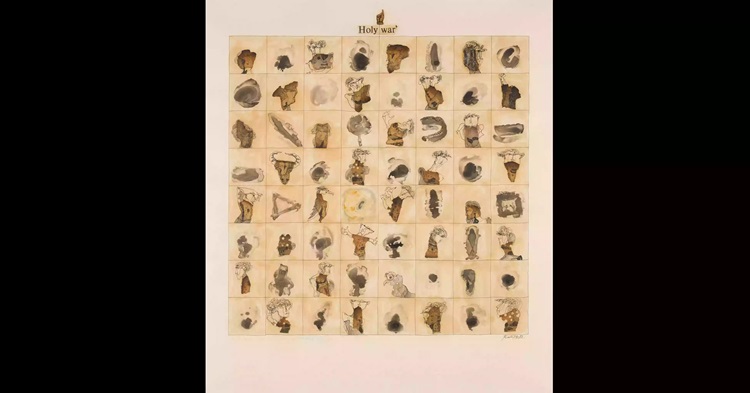Kalidas Karmakar’s ‘Holy War’ attains global spotlight at Sotheby’s auction


Works of celebrated Bangladeshi masters, including Shilpacharya Zainul Abedin (1914–1976), Mohammad Kibria (1929–2011), Rashid Chowdhury (1932–1986), Kalidas Karmakar (1946–2019) and Shahid Kabir (b.1949), have been showcased in this year’s Sotheby’s auction of South Asian Modern & Contemporary Art in London, alongside renowned artists from India, Pakistan and Sri Lanka.
Under the segment titled 'Five Bangladeshi Jewels' on Sotheby’s website, the estimated price ranges for these works are: Zainul Abedin’s Untitled (£15,000–20,000), Rashid Chowdhury’s Untitled (£10,000–15,000), Mohammad Kibria’s Untitled (£12,000–18,000), Shahid Kabir’s Mosque, Lalan and Temple; Lalan on White Horse; Jatra Stage of Time (£7,500–9,500), and Kalidas Karmakar’s ‘Holy War’ (£1,500–2,500).
The combined lower estimate for the Bangladeshi works stood at £46,000; however, they eventually ended up being collectively sold for £181,610.
The auction, presented by Sotheby’s Indian and South Asian Art department, began on Tuesday at 2 pm local time. Among its highlights was ‘Holy War’, a rare 1978–79 work by the late Bangladeshi maverick Kalidas Karmakar (1946–2019), widely regarded as a pioneer of experimental printmaking and contemporary visual language in Bangladesh.
The mixed-media composition, measuring 60.2 x 50.9 cm, is executed in pen, ink, gouache and collage on paper. Inscribed “Pen and Ink Drawing, Gouache, collage, Kali ‘78–79” along the lower edge, the piece was originally acquired in Dhaka around 1979–80, later entering a private collection in Spain.
According to Sotheby’s catalogue, Karmakar’s ‘Holy War’ series reflects on the violence and futility of conflict through fragmented grids, layered collages, and pen-drawn symbols. A relentless experimentalist, he introduced unconventional materials such as sand, fabric and metal into his collages and installations, drawing inspiration from surrealism, abstraction and tantric philosophy in search of universal meaning.
“Like a river, ever flowing and unbound, Kalidas Karmakar has been a wandering soul, his nomadic and restless mind taking him places untraveled and subjects unexplored. Although a globetrotter, he always anchors himself in his native Bangladesh, finding inspiration from its alluvial soil and heroic past,” wrote art critic H. Ferdous in Kalidas Karmakar: Alluvial Soul Soil Symbol, Artcon (2016), quoted in the Sotheby’s catalogue.
Born in Faridpur in 1946, Karmakar studied at the Institute of Fine Arts, Dhaka, and the Government College of Art & Craft, Kolkata, later pursuing advanced training in Poland, Japan and France. From his first major solo exhibition in Dhaka in 1976, he went on to stage more than 90 solo shows worldwide. His contributions to Bangladeshi art earned him numerous accolades, including the Ekushey Padak, the nation’s second-highest civilian award.
Only three works from the ‘Holy War’ series have surfaced to date, incorporating burnt paper along with other experimental mediums.
Speaking on the significance of the series, ARK Reepon, founder of Artcon, said: “Kalidas Karmakar’s ‘Holy War’ works are rooted in the Liberation War of 1971, created from his personal experiences during that turbulent period. One of these belongs to Artcon’s collection. Of the three known works in the series, two are reproduced in the artist’s monograph KALIDAS: Alluvial Soul . Soil . Symbol (Artcon, 2025)."
"The Sotheby’s auction piece, believed to be the first in the series, has resurfaced after decades, finding its place on the global stage. Seeing Bangladeshi artworks sold internationally not only raises their value but also brings to light unseen works of our master artists, giving them well-deserved global recognition,” ARK Reepon told UNB.
Regarding the matter, Gallery Cosmos Artistic Director Sourav Chowdhury spoke to UNB, stating: “In 2015, Gallery Cosmos exhibited another work from the ‘Holy War’ series in our ‘Braveheart’ exhibition. Kalidas was deeply associated with our gallery from the beginning, and seeing the series now gain international recognition at Sotheby’s auction is a proud moment for us.”
Speaking recently to Prothom Alo on Bangladesh’s position in the South Asian art landscape, Manjari Sihare Sutin, Co-Worldwide Head of Sotheby’s Indian and South Asian Art Department, said: “Bangladeshi artists have created both figurative and abstract visual languages that honour the country’s history and vibrant culture. Zainul Abedin’s truthful depictions of ordinary lives earned him the title of Shilpacharya, while the abstract paintings of Mohammad Kibria and Aminul Islam captured the luminous colours of Bangladesh’s natural landscapes.”
In recent years, Bangladeshi artworks have garnered increasing international attention. In September 2024, Zainul Abedin’s 1970 geometric drawing on paper, initially valued at £10,000–15,000, fetched a record £516,000 (Tk 8.25 crore) at Sotheby’s—marking the highest auction price ever for his work.
Founded in 1744, Sotheby’s has been holding dedicated auctions of South Asian Modern & Contemporary Art since 1995. Its March 2025 New York sale of South Asian works generated $16.8 million—over three times the lower pre-sale estimate—with a sell-through rate of 95.5 percent and 84 percent of lots surpassing their high estimates.
Kalidas Karmakar’s ‘Holy War’ now joins this dynamic legacy, reaffirming the global resonance of Bangladeshi modern and contemporary art.
